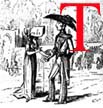 he most closely knit narrative in the Waverley series, The Bride of Lammermoor (1819), in the third group of Tales of my Landlord, is set against the tempestuous backdrop of the Glorious or Bloodless Revolution of 1688-9; it recounts the tale of the Ravenswood family, which chose to remain loyal to the Stuart cause when England's last Stuart king, James II, was deposed in favour of his Protestant son-in-law, William of Orange. Deprived of his title for his part in the Civil War and of his East Lothian estates by the devious Whig lawyer Sir William Ashton, the surviving son inherits his father's hatred of the upstart trickster Ashton whom he holds responsible for his father's dieing of a fit. The sombre young Master of Ravenswood lives on the only property left his family, the ruinous Wolf's Crag castle, attended by the faithful family retainer, Caleb Balderstone.
he most closely knit narrative in the Waverley series, The Bride of Lammermoor (1819), in the third group of Tales of my Landlord, is set against the tempestuous backdrop of the Glorious or Bloodless Revolution of 1688-9; it recounts the tale of the Ravenswood family, which chose to remain loyal to the Stuart cause when England's last Stuart king, James II, was deposed in favour of his Protestant son-in-law, William of Orange. Deprived of his title for his part in the Civil War and of his East Lothian estates by the devious Whig lawyer Sir William Ashton, the surviving son inherits his father's hatred of the upstart trickster Ashton whom he holds responsible for his father's dieing of a fit. The sombre young Master of Ravenswood lives on the only property left his family, the ruinous Wolf's Crag castle, attended by the faithful family retainer, Caleb Balderstone.
By chance, Ravenswood saves Ashton and his beautiful daughter, Lucy, from a stampede of Highland cattle. When political events raise friends to power, Ashton deems it advisable to agree to a match between his daughter and the young laird. Although her daughter has fallen in love with the Stuart sympathiser, Lady Ashton, an overbearing and virulent Whig adherent, returning home, cancels the marriage. Determined to see Lucy marry the Lord of Buclaw instead, Lady Ashton oppresses her daughter, who appears to yield, believing Ravenswood to have abandoned her after her mother has contemptuously dismissed him. Returning from a foreign mission on the day of the wedding, Ravenswood, challenges the new husband and Lucy's brother to a duel, but Lucy, going mad, stabs her husband on the wedding night, and shortly afterward dies. The next day, in his furious haste, to confront his enemies Ravenswood, forgetting the quick sand on the seashore, gallops to his doom.
The supernatural elements that support the ominous atmosphere (at once established by the opening funeral) seem related to the traditional ballads of the Scottish border, as does the elaborate use of symbolic imagery. The warning of Blind Alice, the wishing well, and the three witches in the kirkyard (obviously borrowed from Macbeth) all contribute to the Gothic background which dominates the action, fatalism conditioning the actions of the principal characters as the curse that foretells tragedy for the brooding hero and the innocent heroine works itself out relentlessly. Balderstone, the typical quirky servant in the tradition of Cervantes' Sancho Panza, provides the necessary comic relief through his attempts to provision Wolf's Crag and maintain the family's dignity in the face of poverty.
Since the action of the novel occurs just prior to the 1707 Act of Union between Scotland and England, approximately at the time of Queen Anne's accession, the novel seems intended to commemorate what Jane Millgate terms "the dying moments of Scotland's identity as a separate nation" (173). The demands of romance and melodrama determine that Ravenswood, like Scott's other heroes a noble youth with the potential for action, restrict the protagonist's freedom to act without regard to familial obligation, the code of vengeance, and societal superstition. Scott skilfully blends Spenserian romance and the latter-day Gothic conventions of Matthew G. "Monk" Lewis in his manipulation of the plot through supernatural agency and coincidence. Despite the use of dialect, especially in the dialogue of Balderstone, vocabulary and cultural differences apparently did not interfere with contemporary English readers' understandings of the plot and characters.
John Buchan contends that The Bride of Lammermoor is atypical of Scott's novels in that it ends tragically, with no hope for the future, its characters engulfed in a destiny beyond their control. The terrible darkness is only momentarily relieved by Caleb Balderstone's "raid" on the nearby village of Wolf's-hope in order to provision his master's castle for the unexpected reception of Sir William Ashton and his daughter. Scott wrote it, as Coleridge wrote "Kubla Khan," in a drugged and abnormal condition; in fact, having no recollection of its composition, he pronounced it "monstrous, gross and grotesque" at the completion of his first reading. The essential contrast of the book is between the nouveau riche, "Whig" nobility exemplified by the Ashtons, middle class entrepreneurs raised by the House of Hanover to the governing class, and the poverty and pride of the traditional land-owning class, exemplified by Ravenswood. The story's single concession to sentimentality is the large sable feather's floating on the rising tide to Caleb's feet after his Lord's perishing in the quicksands of Kelpie's Flow: "The old man took it up, dried it, and placed it in his bosom" (Ch. XXXV). The novel's great strength, contends Buchan, is Scott's handling of descriptions of the East Lothian landscape, anticipating Hardy's animation of Egdon Heath in The Return of the Native (1878).
Last modified 30 December 2001